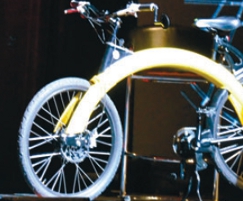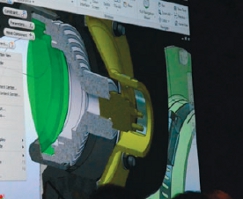As The Good Doctor once said, “I hate to say this, but this place is getting to me. I think I’m getting the Fear.”
It’s December 3rd and I find myself sat in a penthouse suite looking out on a dazzling array of wealth extraction facilities. We’re not usually ones for luxury at DEVELOP3D, but we have the web-based hotel search bargain hunting skills of our dear Greg Corke to thank for this.
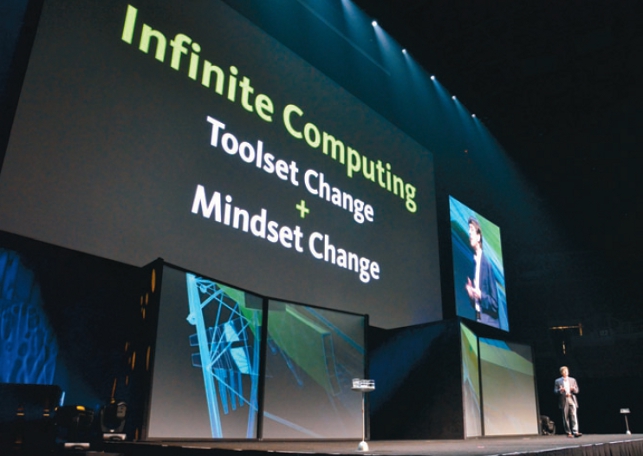
Now safe away from the chaos of the Mandalay Bay conference hotel, I’m sat here in my high grade formica and faux marble room, trying to clear my head and wrap up my thoughts on the week I’ve just spent in Las Vegas, Nevada.
Autodesk University, or AU, is one of the design technology industry’s most interesting events. It’s absolutely massive, covers an unparalleled breadth of industries, and attracts attendees from all walks of life.
This year over 7,000 people were in attendance ranging from architects and construction specialists, infrastructure managers and civil engineers and of course, those from our own little community, manufacturing and product design professionals.
Taking a week out of work is a big investment but there is much to learn. Attendees gain an insight into the future of Autodesk, have access to a vast range of classes and training sessions and, of course, there’s no better opportunity for networking and exchanging ideas.
The event has a tried and tested format. It centres on keynotes, from both the senior executives of Autodesk and its customers.
Last year’s presentation by John Landis on the Avatar movie was always gong to be a tough act to follow, but this year’s headline ‘event’ was a preview of the forthcoming Tron: Legacy movie.
This featured a presentation on how visual effects trickery brought Jeff Bridges back to reprise his role as Kevin Flynn.
The keynotes also gave the big dogs at Autodesk the chance to talk about the technology they’re working on, what they see coming in the future, and some of the challenges we’re going to face.
One of the most fascinating customer stories in the Manufacturing keynote sessions came from bicycle innovators, Pi Mobility.
The company has developed some new strikingly original looking electric bicycles which are capable of between 20-30 miles per charge at 20 mph.
Founder Marcus Hays gave a presentation on the development of the bicycles which are not only striking but also give the equivalent of 1,200 miles per gallon.
These bikes are currently on sales for between $2,995 and $4,995.
The changing face of Autodesk
Autodesk is, without a doubt, one of the most interesting vendors to watch at the moment. For many years the company relied on AutoCAD as its cash cow and was often a follower rather than a leader, but this has changed dramatically in the last few years.
Much of this is down to having Carl Bass at the helm, a gentleman who not only appears to have an insatiable fascination with technology, but also the work that the users are doing with it.
There’s very few CEOs that can sit down to dinner and discuss techniques for improving the structural stability of wood using steam, the pros and cons of the 3D printing devices that he uses in his private workshop, or the intricacies of ‘tuning’ a desktop computer to make it run silent.
Autodesk labs and fusion
For me, the most exciting part of this new Autodesk is its online Labs project.
Here users can experiment with a range of developmental technologies, provide feedback and see them evolve. Not everything makes it out of Labs into a shipping product, but one technology that is sure to graduate is Fusion, a technology that is applicable to virtually anyone who wants to engage in 3D design.
Fusion is a proving ground for both new user interface and direct editing techniques. The technology has come a long way since it was introduced in 2009 and now incorporates surface modelling techniques in addition to its solid modelling foundation.
The news out of the event was that Autodesk is starting to finalise its plan for the technology. We all knew that Fusion would, at some point, be integrated into core Inventor, but what many have been wondering is if it can also have a life as a separate application.
Carl Bass discussed the potential for Fusion to be made available to the hobbyist market and at the same time, bundled with AutoCAD.
While these are early days, I’d predict that you may well see Fusion packaged with AutoCAD to add to the increasing set of 3D tools, as well as seeing it offered to the market at a ‘lowish’ cost.
The Cloud
Putting Fusion aside for a moment, the real groundbreaking work at Autodesk is being done in the cloud.
Why would you spend days waiting for multiple mould filling simulations to run when they could be sent off for calculation and the results sent back in a much shorter time frame?
Why wouldn’t you want to use an accelerated method of design optimisation, to run through many more variants of a part to fine tune and optimise their form for strength and cost?
Autodesk’s Chief Technology Officer (CTO), Jeff Kowalksi, alluded in his keynote how many of these experiments are accelerating existing workflows and adapting existing processes to a different computation platform.
You’ve always been able to do this type of task, but now you can do it more quickly. He also discussed the fact there will be a shift away from this idea of making existing process faster and the smart vendors will start to build tools specially designed for a cloud-based environment with all its inherent benefits.
Kowalski also introduced a term that Autodesk has adopted to describe this processor or computation rich shift -“Infinite Computing”. He described how the cloud gives you near-limitless computation capability. and that it not only brings about a change in toolset, but a change in mindset, with users being able to think about the design process in new ways.
Personally, I’ve got issues with the use of the term Infinite. Computation in the cloud is never going to be infinite, but it can give companies access to previously unobtainable of levels of processing power.
On the subject of the cloud, I had a number of discussions on the cost of such services as these projects move from Labs to commercialisation and sale. Things are as yet undecided, but many within Autodesk are looking to see what can be offered as part of the subscription service.
Perhaps it will be a specific amount of CPU hours on a computation cloud tied in with a specific storage allowance for datasets and results, with add-on allowances being separately purchasable.
That would seem to make huge sense and is in line with how SaaS services are charged at the moment.
Conclusion
There are two occasions in the year that we get to see what Autodesk has up its sleeve and what it is working on.
The global rollout of all of its products is one, usually around April or May. This is then followed up with AU at the end of the year.
It’s clear that the company is pursuing many interests, many tangents and many areas of potential. It has gone from being a company that many perceived as being a follower to being a company that’s leading by example in many respects.
Its Labs projects are serious endeavours that are being tried out, experimented with and fine tuned in the public eye and the results are quite astounding. Many of these are not only making it to market, but are becoming very highly used and key applications.
But what of the event? AU is a huge event and there are a wide range of users, split into different camps, different industries. What interested me most was the crossover between those industries.
I spoke to architects and civil engineers in manufacturing sessions, there to learn about Alias, Inventor and other things, to see if and how they could integrate these tools into their workflows.
Conversely, I spoke to a couple of designers/engineers registered for the manufacturing stream who were checking out Autodesk’s Revit application to see how they could best provide data for architects to use efficiently.
This is perhaps the best example of what AU is all about; it’s about learning, networking and opening your eyes to new ideas, and for that reason people continue to return year on year.
au.autodesk.com
Sustainability at the core
One subject that continually raised its head at the event can be summed up with one word: Sustainability.
Helping minimise the environmental impact of products that are designed with Autodesk software is now a core focus for the company.
A large proportion of Autodesk’s customers are within the AEC (Architecture, Engineering Construction) industry and Green Design for buildings is a red hot topic.
For those of us focussing on the product development and manufacturing world, the pressures are not, as yet, under quite as much legislative pressure, but it’s coming and the chances are, depending on where you are in the world, it’s coming soon.
Several of the keynotes touched on the subject, none more so than the Tesla Motors presentation. The company has been taking the electric vehicle world by storm, by bucking the trend for hideous design being synonymous with electric car design and creating high-value vehicles that run on alternatives to fossil fuels.
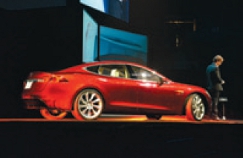
The Model S, Tesla Motors new electric saloon car
The team brought onto stage the Model S (pictured right) that sees the company introduce a new electric saloon car with four proper seats, to go alongside its two seater sports-cars.
Alongside the keynotes, there was serious discussion during the conference sessions about the tools and techniques that Autodesk has to offer the manufacturing community.
Several of the conference tracks dealt with the business end of sustainable design, specifically how several of Autodesk’s initiatives are looking to reduce the environmental impact of resultant products.
For example, technologies such as the Optimisation tools should be able to assist with light-weighting as it’s possible to conduct a much larger number of iterations in an optimisation study than was previously possible.
There was also a discussion about Autodesk’s partnership with Granta Design, which should see much more data being made available about materials for use in the design process.
But alongside tagging up its product portfolio with applicable potential in green design, it’s clear that Autodesk is looking to help educate its users and future users.
This is in evidence in the Sustainability Workshop which features a great deal of engaging content to help those new to the field with gaining a better understanding of the concepts and how they’re applied.
And for everyone, it’s worth a visit at students.autodesk. com/?nd=sustainable_ home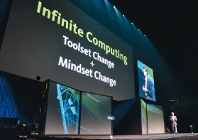
Our full report from the huge Las Vegas event


